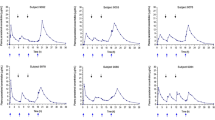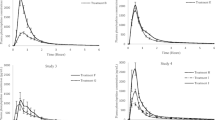Summary
In many countries, the pyrazolone derivatives, which include dipyrone, antipyrine, aminopyrine and propyphenazone, are widely used analgesics. Dipyrone, the most widely used pyrazolone, has been the most studied. The pyrazolidine derivatives, phenylbutazone and oxyphenbutazone, which are not generally used for analgesia since they differ from the pyrazolones in terms of efficacy and tolerance, are not discussed in this article.
Dipyrone is an inhibitor of cyclo-oxygenase but, unlike aspirin, its effect is rapidly reversible. The inhibition of prostaglandin biosynthesis contributes to the analgesic activity of the pyrazolone derivatives.
Peak plasma concentrations of the pyrazolone derivatives generally occur 1 to 1.5 hours after oral administration. Half lives vary from 1 to 2 hours with propyphenazone, to about 7 hours with dipyrone (2 hours for the active metabolite of dipyrone, 4-methylaminoantipyrine, MAA). Half life of antipyrine varies considerably between individuals (5 to 35 hours). Unlike the NSAIDs generally, the pyrazolone derivatives antipyrine, aminopyrine and propyphenazone are minimally bound to plasma proteins. The pyrazolones undergo extensive biotransformation, aminopyrine and dipyrone being converted to active metabolites.
Dipyrone is the only drug for which results of recent double-blind trials are available. Oral dipyrone has been shown to be more effective than an equal dose of aspirin or paracetamol in alleviating postoperative pain, and intravenous dipyrone 2.5g was similar in efficacy to pethidine 50mg. In patients with acute ureteral or biliary colic, dipyrone 2.5g intravenously was similar in efficacy to indomethacin 50mg or pethidine 50mg.
The most frequently reported side effects of the pyrazolone derivatives are skin rashes. Gastrointestinal side effects are rare. Blood dyscrasias, mostly associated with aminopyrine, have received wide attention in the medical literature, but their true incidence with dipyrone is considerably lower than the often quoted incidence for amidopyrine reported more than 30 years ago.
Similar content being viewed by others
References
Ajgaonkar, V.S. and Pinto Pereira L.M.: Patient study of antipyretic drug efficacy. Current Therapeutic Research 37: 440–445 (1985).
Arndt, K.A. and Jick, H.: Rates of cutaneous reactions to drugs. A report from the Boston Collaborative Drug Surveillance Program. Journal of the American Medical Association 235: 918–923 (1976).
Bach, B.; Molholm Hansen, J.; Kampmann, J.P.; Rasmussen, S.N. and Skovsted, L.: Disposition of antipyrine and phenytoin correlated with age and liver volume in man. Clinical Pharmacokinetic 6: 389–396 (1981).
Badian, M.; Le Normand, Y.; Rupp, W. and Zapf, R.: There is no interaction between dipyrone (metamizol) and the anticoagulants, phenprocoumon and ethylbiscoumacetate in normal Caucasian subjects. International Journal of Pharmaceutics 18: 9–15 (1984).
Barroso, M.H.; Carranza, J.A.U.; Garcia, J.L.G. and Rodriguez, L.G.: Evaluacion doble ciego de la eficacia analgesica y tolerancia de zomepirac sodico y dipirona, a dosis unica en dolor posoperatorio. Investigation Médica Internacional 9: 164–170 (1982).
Bax, N.D.S.; Lennard, M.S. and Tucker, G.T.: Inhibition of antipyrine metabolism by β-adrenoceptor antagonists. British Journal of Clinical Pharmacology 12: 779–784 (1981).
Boston Collaborative Drug Surveillance Program: Dipyrone as a cause of drug rashes. International Journal of Epidemiology 2: 167–170 (1973).
Brune, K. and Alpermann, H.: Non-acidic pyrazoles: Inhibition of prostaglandin production, carrageenan oedema and yeast fever. Agents and Actions 13: 360–363 (1983).
Brunk, S.F.; Combs, S.P.; Miller, J.D.; Delle, M. and Wilson, W.R.: Effects of hypothyroidism and hyperthyroidism on dipyrone metabolism in man. Journal of Clinical Pharmacology 14: 271–279 (1974).
Christ, O.; Kellner, H.M.; Ross, G.; Rupp, W. and Schwarz, A.: Biopharmaceutische und pharmakokinetische Untersuchungen nach Gabe von Metamizol 14C an Ratte, Hund und Mensch. Arzneimittel-Forschung 23: 1760–1767 (1973).
Comeri, C.; Radice, G.P.; Duvia, R.; Manganini, V. and Monza, G.: Efficacy and safety of non steroidal anti-inflammatory drugs in ureteral colic. A double-blind controlled trial. [Abstract No.71.] Urological Research 12: 45 (1984).
Crooks, J.; O’Malley, K. and Stevenson, I.H.: Pharmacokinetics in the elderly. Clinical Pharmacokinetics 1: 280–296 (1976).
Czerniawska-Mysik, G. and Szczeklik, A.: Idiosyncrasy to pyrazolone drugs. Allergy 36: 381–384 (1981).
Daas, M.; Gupta, M.B.; Gupta, G.P. and Bhargava, K.P.: Role of biogenic amines in the ulcerogenic action of analgin and paracetamol in albino rats. Indian Journal of Medical Research 67: 677–681 (1978).
Daftary, S.N.; Mehta, A.C. and Nanavati, M.: A controlled comparison of dipyrone and paracetamol in post-episiotomy pain. Current Medical Research and Opinion 6: 614–618 (1980).
Dembinska-Kiec, A.; Zmuda, A. and Krupinska, J.: Inhibition of prostaglandin synthetase by aspirin-like drugs in different microsomal preparations; in Samuelsson and Paoletti (Eds) Advances in Prostaglandin and Thromboxane Research, vol. 1, pp.99–103 (Raven Press, New York 1976).
Discombe, G.: Agranulocytosis caused by amidopyrine. An avoidable cause of death. British Medical Journal 1: 1270–1273 (1952).
Drehsen, G.; Derendorf, H. and Rohdewald, P.: Onset of action after administration of mild analgesics. Münchener Medizinische Wochenschrift 126: 736–738 (1984).
Eichelbaum, M.: Drug metabolism in thyroid disease. Clinical Pharmacokinetics 1: 339–350 (1976).
Eldor, A.; Zylber-Katz, E. and Levy, M.: The effect of oral administration of dipyrone on the capacity of blood platelets to synthetize thromboxane A2 in man. European Journal of Clinical Pharmacology 26: 171–176 (1984).
Gebel, K. and Hornstein, O.P.: Drug induced oral erythema multiforme. Results of a long term retrospective study. Dermatologica 168: 35–40 (1984).
Gomez-Jimenez, J.; Franco-Patino, R.; Chargoy-Vera, J. and Olivares-Sosa, R.: Clinical efficacy of mild analgesics in pain following gynaecological or dental surgery: Report of multicentre studies. British Journal of Clinical Pharmacology 10: 355S–358S (1980).
Greenblatt, D.J.; Franke, K. and Huffman, D.H.: Impairment of antipyrine clearance in humans by propranolol. Circulation 57: 1161–1164 (1978).
Grossman, W.: Treatment of colic of the urinary tract. Urologie and Cutaneous Review 46: 353–354 (1942).
Jurna, I.: Mechanismen der Schmerzunterdruckung durch pharmaka. Münchener Medizinische Wochenschrift 127: 573–578 (1985).
Karim, M.: Antipyretic effects of novalgin in children. Pakistan Medical Review 2: 52–57 (1967).
Kulkarni, R.D.: Bakhle, D.S. and Pinto Pereira, L.M.: Objective evaluation of antipyretic activity in human volunteers. IRCS Medical Science 13: 148–149 (1985).
Lai, A.; Pandey, K.; Chandra, P. and Pande, S.B.: Dipyrone for treatment of post-operative pain. Anaesthesia 28: 43–47 (1973).
Lehtonen, T.; Kellokumpu, I.; Permi, J. and Sarsila, O.: Intravenous indomethacin in the treatment of ureteric colic. Annals of Clinical Research 15: 197–199 (1983).
Levy, M.: Pharmacokinetics of dipyrone metabolites. Proceedings of a Symposium 100 Jahre Pyrazalone, Erlangen, West Germany October 1984.
Levy, M.; Flusser, D.; Zylber-Katz, E. and Granit, L.: Plasma kinetics of dipyrone metabolites in rapid and slow acetylators. European Journal of Clinical Pharmacology 27: 453–458 (1984).
Lorenzetti, B.B. and Ferreira, S.H.: Mode of analgesic action of dipyrone: direct antagonism of inflammatory hyperalgesia. European Journal of Pharmacology 114: 375–381 (1985).
Lüthy, C.; Multhaupt, M.; Oetliker, O. and Perisic, M.: Differential effect of acetylsalicylic acid and dipyrone on prostaglandin production in human fibroblast cultures. British Journal of Pharmacology 79: 849–854 (1983).
Matzer, Y.; Drexler, R.; Levy, M.: Effect of dipyrone, acetylsalicylic acid and acetaminophen on human neutrophil chemotaxis. European Journal of Clinical Investigation 14: 440–443 (1984).
Mehta, S.: Comparison of pethidine with sodium phenylalmethyl pyrazolone methylaminomethane sulphonate (Novalgin) and with a placebo in postoperative pain. Indian Journal of Anaesthesia 232–237 (1967).
Mukherjee, S. and Sood, S.: A controlled evaluation of orally administered aspirin, dipyrone and placebo in patients with postoperative pain. Current Medical Research and Opinion 6: 619–623 (1980).
Niinikoski, J.; Nelimarkka, O. and Pekkola, P.: Intravenous indomethacin in biliary pain. Annales Chirurgiae et Gynaecologiae 73: 69–72 (1984).
Nikolov, R.; Nikolova, M. and Peneva, M.: Study of dipyrone (Analgin) antagonism toward certain pharmacological effects of prostaglandins E2 and F2α; in Ovtcharov and Pola (Eds) Dipyrone, Proceedings of a Symposium in Moscow 1978, pp.83–89 (Schattauer Verlag 1980).
Nikolova, M.; Stefanova, D.; Nikolov, R. and Daleva, L.: Comparative pharmacological study of dipyrone and acetylsalicylic acid: Analgesic effects; in Ovtcharov and Pola (Eds) Dipyrone, Proceedings of a Symposium in Moscow 1978, pp.91–97 (Schattauer Verlag 1980).
Nöschel, H.; Peiker, G.; Voigt, R.; Meinhold, P.; Müller, B.; Schröder, S. and Bonaw, A.: Research on pharmacokinetics during pregnancy. Archives of Toxicology 4 (Suppl.): 380–384 (1980).
O’Malley, K.; Crooks, J.; Duke, E. and Stevenson, I.H.: Effects of age and sex on human drug metabolism. British Medical Journal 3: 607–609 (1971).
Paeile, C. and Gallardo, F.: Analagesic activity of pentazocine and dipyrone in ambulatory oral patients. Journal of Oral Surgery 32: 191–194 (1974).
Patel, C.V.; Koppikar, M.G.; Patel, M.S.; Parulkar, G.B. and Pinto Pereira, L.M.: Management of pain after abdominal surgery: Dipyrone compared with pethidine. British Journal of Clinical Pharmacology 10: 351S–354S (1980).
Prescott, L.F.: Clinically important drug interactions; in Avery (Ed.) Drug Treatment, pp.236–262 (ADIS Press, Sydney 1980).
Reinberg, A. and Smolensky, M.H.: Circadian changes of drug disposition in man. Clinical Pharmacokinetics 7: 401–420 (1982).
Reiner, M.; Massera, E. and Magni, E.: Nimesulide in the treatment of fever: A double-blind crossover clinical trial. Journal of International Medical Research 12: 102–107 (1984).
Rejman, F.: Intravenous indomethacin in biliary pain: A clinical investigation with metamizole as the control. IRCS Medical Sciences 12: 399–400 (1984).
Rohdewald, P.; Drehsen, G.; Milsmann, E. and Derendorf, H.: Relationship between saliva levels of metamizole metabolites, bioavailability and analgesic efficacy. Arzneimittel-Forschung 33: 985–988 (1983).
Rupp, W.; Dagrosa, E.E.; Malerczyk, V.; Schleyerbach, R.; Fischer, C. and Frölich, J.C.: Effects of indomethacin and metamizol on thromboxan B2 synthesis, platelet aggregation and renal excretion of PGE2-metabolite in normal subjects: Evidence of differential effects on platelets and stomach. Paper presented at the 5th International Conference on Prostaglandins, Florence, Italy, May 1982.
Schaefer, A.; Komlos, M. and Seregi, A.: Effects of biogenic amines and psychotropic drugs on endogenous prostaglandin biosynthesis in the rat brain homogenates. Biochemical Pharmacology 27: 213–218 (1978).
Schiantarelli, P.; Murmann, W. and Magi, S.: Investigation of rociverine plus dipyrone for antispasmodic and analgesic interactions. Arzneimittel-Forschung 29: 760–765 (1979).
Schröder, S.; Müller B. and Peiker, G.: Determination of ampicillin and metamizol (Analgin) in the milk from patients suffering from mastitis. Zbl. Pharm 122: 1369–1371 (1983).
Schroth, H.J.; Steinstrassen, A.; Berberich, R. and Kloss, G.: Moteletät der ableitenden Harnwege. Münchener Medizinische Wochenschrift 127: 227–228 (1985).
Sjöqvist, F.; Borgå, O. and Orme, M.L.’E.: Fundamentals of clinical pharmacology; in Avery (Ed.) Drug Treatment, pp. 1–61 (ADIS Press, Sydney 1980).
Skjelbred, P. and Løkken, P.: Phenazone versus placebo: Effects on post-operative course. European Journal of Clinical Pharmacology 18: 327–331 (1980).
Van Duin, C.Th.M.; Van Essen, J.A. and Van Miert, A.S.J.P.A.M.: Mechanism of antipyretic action of salicylates and pyrazolone derivatives. Zentralblatt für Veterinarmedizin A 22: 510–519 (1975).
Van Miert, A.S.J.P.A.M.; Van Essen, J.A. and Tromp, G.A.: The antipyretic effect of pyrazolone derivatives and salicylates on fever induced with leukocytic or bacterial pyrogen. Archives Internationales de Pharmacodynamie et de Therapie 197: 388–391 (1972).
Viktorov, I.; Patrashkov, T.; Zlatanova, L.; Koleva, P.: A clinical study of dipyrone (analgin) in urologie patients; in Ovtcharov and Pola (Eds) Dipyrone, Proceedings of a Symposium in Moscow 1978, pp.37–42 (Schattauer Verlag 1980).
Volz, M. and Kellner, H.-M.: Kinetics and metabolism of pyrazolones (propyphenazone, aminopyrine and dipyrone). British Journal of Clinical Pharmacology 10: 299S–308S (1980).
Weinberger, I.; Joshua, H.; Friedmann, J.; Rahamim, S. and Agmon, J.: Inhibition of ADP-induced platelet aggregation by dipyrone in patients with acute myocardial infarction. Thrombosis and Haemostasis 42: 752–756 (1979).
Weithmann, K.U. and Alpermann, H.-G.: Biochemical and pharmacological effects of dipyrone and its metabolites in model systems related to arachidonic acid cascade. Arzneimittel-Forschung 35: 947–952 (1985).
Zylber-Katz, E.; Granit, L. and Levy, M.: Plasma protein binding of dipyrone metabolites in man. European Journal of Clinical Pharmacology 29: 67–71 (1985).
Author information
Authors and Affiliations
Rights and permissions
About this article
Cite this article
Brogden, R.N. Pyrazolone Derivatives. Drugs 32 (Suppl 4), 60–70 (1986). https://doi.org/10.2165/00003495-198600324-00006
Published:
Issue Date:
DOI: https://doi.org/10.2165/00003495-198600324-00006




